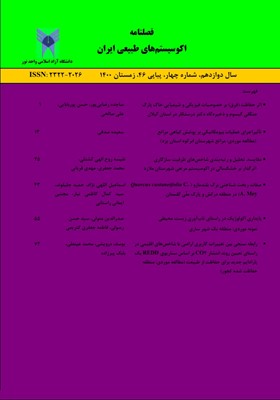مقایسه، تحلیل و رتبهبندی شاخصهای ظرفیت سازگاری اثرگذار بر خشکسالی در اکوسیستم مرتعی شهرستان ملارد
محورهای موضوعی : مرتعداری
کلید واژه: خشکسالی, ملارد, مدیریت مشارکتی مرتع, بهرهبرداران مرتع, سامان عرفی, حفاظت آب و خاک,
چکیده مقاله :
مراتع یکی از ثروتهای حائز اهمیت برای نسلهای کنونی و آینده است که نقش بسیار مهمی در تعادل بومشناختی، درآمدزایی و توسعه روستایی دارد. امروزه به دلایل مختلف سرعت تخریب و بهرهبرداری از این مراتع، بسیار بیشتر از روند تجدید و احیاء آن میباشد و همین پدیده باعث نابودی سطوح گسترده ای از خاک و پوشش گیاهی مراتع شده است. اجرای طرح های مدیریت مشارکتی منابع طبیعی با افزایش سرمایه های اجتماعی و مالی باعث افزایش ظرفیت سازگاری بهره برداران مرتع در مواجه با بحران های زیست محیطی می گردد. هدف از تحقیق حاضر، مقایسه و بررسی شاخصهای اجتماعی-اقتصادی عملیات حفاظت آب و خاک در شهرستان ملارد است. در این پژوهش، شاخصهای ظرفیت سازگاری بر اساس آزمونهای آماری و پرسشنامه ظرفیت سازگاری در دو گروه سامان های عرفی تحت پوشش طرح مدیریت مشارکتی منابع طبیعی (طرح تعمیم ترسیب کربن) و خارج از محدوده این طرح مقایسه شدند. نتایج آزمون تی تک نمونه ای برای مقایسه شاخص های ظرفیت سازگاری در بین دو گروه سامان عرفی نشان داد که از میان پنج مؤلفه (منابع مالی، اطلاعات، مهارتها و مدیریت، زیرساختها، مؤسسات و شبکهها و تساوی حقوق)، به جز مولفه تساوی حقوق، باقی مؤلفه ها در درون و بیرون محدوده طرح دارای اختلاف معنی دار هستند و سامان های عرفی درون طرح مدیریت مشارکتی دارای میانگین بالاتری نسبت به سامان های عرفی خارج از محدوده طرح هستند. در سامان های عرفی درون محدوده طرح مؤلفه مالی و در سامان های عرفی خارج از محدوده طرح نیز مؤلفه زیرساختی دارای اثرگذاری بیشتری در افزایش ظرفیت سازگاری است.
Rangelands are one of the important resources for present and future generations, which plays a very important role in ecological balance, income and rural development. Nowadays, due to various reasons, the rate of destruction and utilization of rangelands is much greater than the process of its renewal and rehabilitation, and this phenomenon has destroyed a wide range of soil and vegetation cover of rangelands. Natural resource co-management projects increase social and financial capital and improve rangeland beneficieries adaptive capacity faced with environmental crises. Present study seeks to compare and investigate socio-economic indicators of water and soil conservation operations in Malard district. In this study, adaptive capacity indicators of two traditional boundaries covered by the project of co-management of natural resources and two out of this area were compared based on statistical tests and adpative capacity questionnaire. One-sample t-test results for comparing adaptive capacity indicators in two traditional boundaries showed that out of five components (financial resources; information; skills and management; infrastructures, instittions, and networks; and equality of rights), except the component of equal rights, others showed significant difference inside and outside the project area. It was found that this indicator was higher in traditional boundaries covered by project. Within those traditional boundaries located within the project area, the financial component was more effective in increasing the adaptive capacity and within those traditional boundaries located out of the project area; infrastructure was more effective in enhancing adaptive capacity.
_||_

